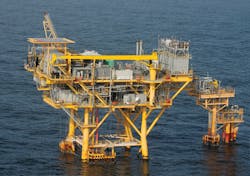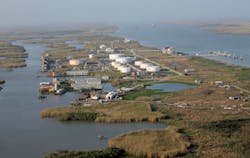Technology helping EPL deliver top-quartile results
AN INTERVIEW WITH GARY HANNA, PRESIDENT AND CEO OF ENERGY PARTNERS LTD.
All photos courtesy of Energy Partners Ltd.
EDITOR'S NOTE: Gary Hanna joined Energy Partners Ltd. [NYSE: EPL] in 2009 and currently serves as president and CEO. He has nearly 30 years' experience in the energy sector, including stints with Admiral Energy Services, Tetra Technologies, Maritech Resources, Tetra Applied Technologies, Gulfport Energy, DLB Oil & Gas, and Hanna Oil Properties. He holds a BBA in economics from the University of Oklahoma. We caught up with him recently to discuss EPL.
OIL & GAS FINANCIAL JOURNAL: Gary, in your analyst day presentation in March, you describe Energy Partners Ltd. as, "Not your typical Gulf of Mexico story." What did you mean by that? How is EPL different from other GOM operators?
GARY HANNA: Don, we target long-lived assets in the central GOM shelf and Gulf Coast with significant upside potential. Some of our assets have reserve lives of 25 years or more. We've worked hard to build the current asset base, and we believe our Gulf of Mexico shelf properties offer some of the industry's most predictable production profiles in the space. The low-risk nature of our operations combined with significant upside potential provides an excellent foundation for building our company.
In addition, our acquire-and-exploit goal is aggressive. We strive to unlock the upside potential of our current and recently acquired assets over a short-time frame. Our target is to at least double the proved reserve base within the assets we acquire. Through a combination of acquisitions and organic growth, we replaced 316% of our production with new proved reserves during 2011.
OGFJ: Talk to us about your position in the Gulf of Mexico. Where do you operate and how does your position advance your strategic goals?
GH: Our company operates in the shallow waters of the central Gulf of Mexico shelf, one of the most prolific oil windows on the shelf. Approximately 78% of all the oil historically produced in the shelf of the Gulf of Mexico is located within our areas of operation, a sediment-rich area containing massive salt domes and fault blocks. Our primary areas wrap around the mouth of the Mississippi River and allow us to tap into multi-stacked pay horizons. Our South Timbalier, Main Pass, South Pass, East Bay, and West Delta projects are all located within close proximity to one another. This dense footprint allows us to share equipment and personnel between projects and generate operational synergies. These synergies help drive down costs, improve margins, and deliver stronger returns on our projects.
In short, our acreage blocks, combined with our operational expertise, provide investors with an opportunity to participate in a shallow-water Gulf of Mexico play consistent of an oily, long-lived reserve base with strong cost controls.
OGFJ: With all of the technological advances we hear about concerning onshore plays, what is new within the Gulf of Mexico these days?
GH: Quite a bit is new. We believe there is a renaissance under way in the region due to advances in technology. This includes taking existing seismic data and refining it through new reprocessing techniques. All of the techniques generally have one thing in common: they are designed to improve the resolution of the existing data. We have embraced this state-of-the-art technology, and to date we have reprocessed over 1,000 square miles of data. The end result is greatly enhanced imaging of our core fields and surrounding areas, which has led to an evolutionary step forward for generating exploitation, exploration and acquisition opportunities.
To further the pursuit of unlocking the potential in our region, we recently have embarked on a regional study to cover the oily window within the Central GOM and Gulf Coast. We will spend $12 million over the next two years focused on this effort. We have a dedicated team already in place and the bulk of the seismic we purchased in house, ready to capture the untapped potential value we believe exists in this prolific area.
EPL acquired additional interest in its existing South Timbalier 41 field this year. Photo courtesy of Energy Partners Ltd.
OGFJ: As an E&P company operating in one of the most competitive markets for oil and gas properties, are acquisitions part of your strategy and what criteria does your M&A team use when an acquisition prospect comes into your shop?
GH: We are always looking for acquisitions that complement our existing footprint in the Gulf of Mexico and along the adjacent Gulf Coast. We like to target oil-weighted fields with high margins, upside potential, and low asset retirement obligation. Our primary goal is to have each acquisition provide additional high-quality development and exploration opportunities to supplement our portfolio. Our strength comes from our technical teams, which quickly identify and unlock opportunities through their understanding of the region and application of technology. To put it simply, Don, we are looking at acquisitions that fit our portfolio and expertise, so we can ultimately add long-term value for our shareholders.
Located 89 miles southeast of New Orleans, EPL's East Bay central facilities lie near the mouth of the Mississippi River in water depths ranging up to approximately 170 feet. Photo courtesy of Energy Partners Ltd.
OGFJ: In 2011, you announced acquisitions that further added to your oil-weighted reserve and production mix. Can you provide us with an update on these acquisitions? Do you see any additional M&A deals on the horizon any time soon?
GH: During 2011, we executed on two targeted acquisitions comprised of significant interests in three major complexes: the West Delta complex, the Main Pass complex, and the South Pass complex. The two transactions provided us an immediate increase in the company's oil weighting, as well as 9.4 MMBOE of proved reserves for approximately $239 million.
As an update, within weeks of closing the acquisitions, we had fully integrated the assets and reduced lifting costs by 13%. Meanwhile, production grew 29% through simple field optimization opportunities, and development and exploration efforts further drove cash flow and reserve growth. As I said earlier, our goal is to double the proved reserve base of the acquired assets. Keeping in mind we bought 9.4 MMBOE of proved reserves, at the end of last year our third-party engineers assessed the 2P reserves at 17 MMBOE. So, we are well on our way of achieving our goal to double, if not triple, the reserves we acquired. The acquisition pipeline for other deals like this one is strong.
As for any additional M&A deals, we recently announced our first acquisition of 2012. We acquired additional interest, roughly a 1 MMBOE, in our existing South Timbalier 41 field. Post-acquisition, we are now the sole working interest owner of the field. This was a good bolt on acquisition with a seamless integration and identified upside with no additional overhead.
We believe we will be able to complete other acquisitions in our core areas that fit our criteria and play to our strengths.
OGFJ: You recently reported First Quarter 2012 results. What drove your success?
GH: Good execution. Our swift move to oil through capital allocation and acquisitions is really starting to show results. It lead to a great year in 2011, and we expect to step up our efforts even more in 2012. During 2011, we completed 39 operations with an overall success rate of 80% and spent roughly $100 million on largely development projects. We have set the bar higher for 2012, stepping up our capital budget to $184 million to increase exploratory drilling within our core fields. We are off to a great start with first-quarter spending at approximately $43.5 million, including 11 successful projects for an 85% success rate year to date. As I said, it comes down to our team's execution and it is a pivotal year for us.
OGFJ: Let's shift gears for a moment and take a look at a few of your operational and financial metrics. Whether we're looking at percent oil reserves, proved reserve life, or net debt to proved barrel of oil equivalent, you seem to outperform your peer group on all levels. Yet, on a cash flow per share multiple, you trade at a discount. What are analysts and money managers missing?
GH: That's a great question, Don, and it's one that hasn't gone unnoticed here at EPL. We pay close attention to our performance metrics, and we deliver top-quartile results across all measures. In fact, our oil-weighted portfolio is 15% to 20% greater than our closest peers. Our reserve life is significantly higher than the peer average. And our net debt to proved reserves is low and is a fraction of the peer average at $3.20. So why does our stock trade at approximately three times cash flow per share (CFPS) when peer group companies are trading close to five times CFPS? We think a lot of it has to do with getting the EPL story in front of more investors. As analysts and money managers become more familiar with EPL's superior metrics, upside potential and our ability to grow both organically and via acquisitions, EPL will find a home in more and more portfolios. Simply put, it's a great time for investment managers to add EPL to their portfolio.
In 2011, EPL acquired significant interests in the West Delta Field. Photo courtesy of Energy Partners Ltd.
OGFJ: Your recently increased 2012 CAPEX budget will exceed your 2011 CAPEX budget by 82%. Why such a large increase and how will you allocate capital in 2012?
GH: Our 2012 capital budget of $184 million has increased and is front-end loaded this year to aid in our oil production ramp and our organic reserve growth. Virtually all of the increase from last year is for close-in exploration of our fields. We have five rigs contracted this year, and as I said before, we have spent $43 million of that budget in the past quarter and are 85% successful on our activities to date. Our overarching theme for 2012 is executing our oil targeted development and infield exploration drilling.
Growth strategies are formulated at EPL's Houston Technology Center using enhanced imaging of the company's core fields. Photo courtesy of Energy Partners Ltd.
OGFJ: What guidance can you provide investors for 2012?
GH: Production is an important factor for any E&P company. In this current price environment, oil is the primary commodity driving revenue and cash flow. A lot of folks are trying to become oily or liquid rich. We are already there with 80% of our total production coming from oil. To top it off, all of our crude oil is price advantaged, selling at or slightly above Brent. Our guidance for 2012 oil production ranges between 9,000 barrels and 10,000 barrels of oil per day, up as much as 24% from 2011. Based on the development and infield exploration drilling I mentioned earlier, we feel confident we will end up averaging within the mid to upper end of that range this year. This year's oil production growth aided by high oil prices should allow our EBITDAX to increase from $224 million in 2011 to around $300 million in 2012.
OGFJ: Is there anything additional you would like to add?
GH: EPL is still a relatively small company, but we're successfully operating on all cylinders and are poised for growth. Our organic growth program, combined with our recent acquisitions, is starting to pay strong dividends. We have significant dry powder to remain acquisitive, with substantial liquidity and a pristine balance sheet. And our portfolio of oil-weighted projects continues to grow through our technical focus and expertise in this prolific region. All of these factors point to strong upside potential and success for EPL.
OGFJ: Thanks for taking the time to talk with us today.
More Oil & Gas Financial Journal Archives Issue Articles
View Oil and Gas Articles on PennEnergy.com





